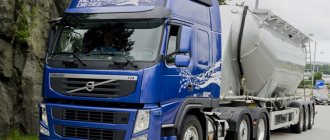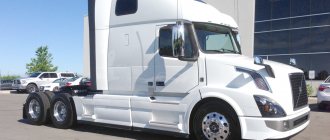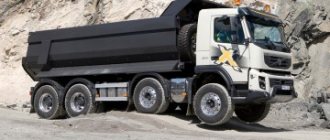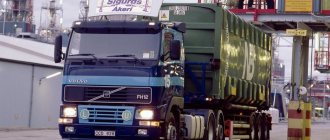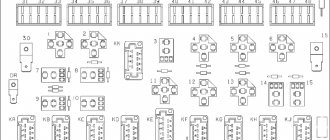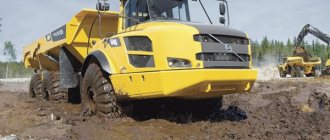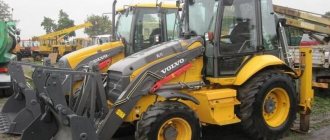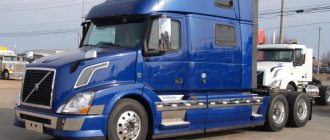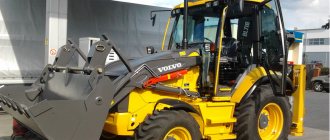Volvo Group in Russia
The history of Volvo Group in Russia began in 2002 with a small plant in Zelenograd.
In 2008, it was decided to close the site and build a large plant in Kaluga that could meet the needs of the Russian market. Kaluga was not chosen by chance. The region has favorable conditions for foreign investors; land plots with communications are provided.
In addition, this settlement is close to Moscow and there are large transport interchanges here. Among other things, there is a developed labor market and technical base: machine-building and turbine-building plants, a technical university and a mechanical engineering college are located in Kaluga.
Investments in the construction of the plant in Kaluga amounted to over 100 million euros
The official opening of the enterprise took place in January 2009. At the same time, a complete machine assembly line was launched.
In the spring of 2009, the plant switched to full-scale assembly based on item numbers. Since November 2014, a workshop for the production of cabins with a capacity of 15,000 units per year has been put into operation. Investments amounted to about 90 million euros.
Since March 2014, production has been reformatted from the classic model of Volvo trucks to a new model range. Today, the plant in Kaluga produces a wide range of commercial equipment for various types of business, in particular, models FH, FM and FMX, FHX.
Volvo FMX family
Volvo FMX is a family of heavy-duty construction trucks. It was developed on the Volvo FM chassis, in 4x4, 6x4, 6x6 and 8x4 versions. The chassis is designed for installation of dump bodies, concrete mixers and other bodies, mainly for construction purposes.
Truck cabs are offered in several options: short and long with a high or standard roof. The ergonomics of the truck are designed taking into account off-road use and construction sites. To achieve this, engine protection, reinforced axles and frame, as well as tanks raised higher than those of the Volvo FM are installed.
Volvo FMX powertrains are powered by D11 step D engines (6-cylinder, 10.8 liter displacement) with a power range of 330, 380, 430 or 460 hp. s., or D13 step D engines (6-cylinder, displacement 12.8 l) with a power range of 420, 460, 500 or 540 l. With. They all run on diesel or HVO. There are special modifications with which it is possible to drive on biodiesel.
Gearbox - manual or automatic: I-Shift (12 gears) or Powertronic.
- Wheel formula: 4x2, 4x4, 6x2, 6x4, 6x6, 8x4, 8x6, 10x4, 10x6.
- Chassis height: medium (900 mm), high (1000 mm), extra high (1200 mm) or extended height (1240 mm).
Rear suspension type: parabolic/multi-leaf, or pneumatic.
Cabin options for Volvo FMX: day cab with internal height of 1605 mm; low day (1480 mm), sleeping (inside height 1605 mm); low sleeper (1480 mm), Globetrotter (201 cm), with two rows of seats (up to 7 passengers), internal height 1590 mm.
Global quality requirements
Volvo Group products and processes comply with the global quality requirements of the concern - Global Quality Requirements (GQR). They are included in assembly instructions (SPRINT) and control documentation. The assembly instructions specify the sequence and order of operations, and also provide control charts. The latter indicate what and how to control.
Thus, on the production line, the correct assembly and functionality of all buttons, lamps, valves are assessed, and the air suspension is calibrated. At the final stage, an additional check of pneumatic systems is carried out for leaks, and traction and dynamometer indicators are tested.
After completing each operation, the employee signs a control sheet. If there is a deviation or impossibility of fulfilling it, for example due to the lack of material or component, a deviation card (remark card) is filled out. Thus, at the exit the car has a whole package of accompanying documentation.
Next, an additional visual and functional check of the brake system, speed characteristics, power, and ABS/EBS system is carried out. Reviewing documentation. Only after this the truck is assigned GOK (Green OK) status.
100% of trucks undergo functional testing
Among other things, the activities of the plant in Kaluga are certified for compliance with ISO 14001 and ISO 9001.
Volvo FL family
This is a family of medium-duty trucks marketed under the slogan “Conqueror of the Urban Elements.” It includes extremely maneuverable and very reliable delivery trucks. They are ideal for intra-city transport with a lot of frequent stopping and starting of the engine. But they can, if desired, be adapted for even more severe operating conditions. Volvo FL are designed for constant everyday use. An expanded range of functions and additional capabilities allow them to always be on the job.
Volvo trucks of the FL family are equipped with D5K or D8K diesel engines.
- The D5K is a 2.4-liter four-cylinder diesel with a maximum power of 210 or 240 hp. and torque 800 or 900 N.m. Cylinder diameter – 81 mm, piston stroke – 93 mm.
- D8K is a 6-cylinder diesel engine with a volume of 7.7 liters and a maximum power of 250 hp. or 280 hp with a maximum torque of 950 or 1050 Nm. Cylinder diameter – 110 mm, piston stroke – 135 mm.
Gearbox – automatic ATO1056, ATO8006 or AL306; or mechanical ZTO1006 or STO8006 – 6 gears; ZTO1109 – 9 gears.
Technical characteristics of Volvo FL trucks
- Gross vehicle weight: 10, 12, 14, 16 or 18 tons.
- Wheel formula: 4x2 or 4x4.
- Wheelbase: 3250, 3350, 3500, 3800, 4100, 4400, 4700, 5000, 5300, 5600, 5900, 6200, 6500 or 6800 mm.
- Chassis height: low (810-830 mm), medium (860 mm), high (950 mm), extra high (960 mm) or extended height (1175 mm, Volvo FL 4x4 only).
- Wheel size: 17.5; 19.5 or 22.5. Tire size: 245/70R17.5; 265/70R19.5; 275/70R22.5; 295/80R22.5 or 11R22.5
- Front axle load: 4; 4.5; 5; 5.6; 5.8; 6.3 or 7.1 tons.
- Rear axle load: 7.4; 7.6; 8; 8.5; 9.2; 9.5; 10.6; 10.9 or 11.5 tons.
Fuel tanks for Volvo FL are available in steel, plastic or aluminum. Capacity from 80 to 300 liters. In addition, provision is made for the installation of two 215-liter tanks with a total volume of 430 liters. The AdBlue reagent tank is made of plastic and has a volume of 32 liters. The AdBlue pump is built into the tank.
Front suspension - leaf spring, parabolic; or on leaf springs, parabolic reinforced; or pneumatic. Rear suspension - spring or pneumatic.
The Volvo FL is equipped with pneumatic brakes with ventilated discs on the front and rear wheels. The electronically controlled anti-lock disc brake system (EBS) provides faster, safer braking with less brake wear.
The system includes ABS, anti-lock brakes, differential locking and ensuring that the braking systems work together. The braking system works together to apply all of the vehicle's brakes, providing even braking and reducing brake and tire wear. An additional function of the EBS system makes starting on a slope easier. There are 3 options for brake disc sizes, depending on the application.
Electronic Stability Assist (ESP-BAS1) helps maintain directional stability in difficult conditions and prevent rollover accidents.
The integrated hydraulic retarder for AL306 gearboxes gives a maximum effect of 400 kW. The maximum ratio in the torque converter (TC421) is 1.77:1.
Cab options for Volvo FL: day cab with internal height of 1605 mm; short bedroom (with a sleeping bunk for one person), also with an internal height of 1605 mm; with two rows of seats (up to 7 passengers), also with an internal height of 1605 mm.
Process audit
Their scheduled audit allows maintaining the quality of production processes. It is carried out by the quality department team.
The purpose of the audit is to confirm that:
- operators assemble and control correctly;
- documentation is completed correctly;
- work is carried out using the necessary and working equipment;
- Data registration in IT systems is carried out correctly.
If deviations in finished products are detected, an unscheduled audit of processes is carried out.
Audit of the finished product
It is carried out selectively. Its purpose is to evaluate the final product before sending it to the client.
Based on the audit results, a report is written in electronic form. It lists all identified errors, indicating the so-called penalty point.
The penalty point is the sum of points for all detected defects, each of which has its own weight. It depends on the criticality of the error.
The audit manual defines four types of errors.
100 points
The error is very serious and can lead to:
- unexpected stoppage or breakdown;
- failure of vehicle systems;
- security threat;
- impossibility of starting the engine.
25 points
The defect is serious, it is necessary to take measures to eliminate it before the next scheduled technical inspection.
5 points
The defect will be detected, but its elimination can be postponed until the next scheduled technical inspection.
1 point
The defect is minor and may only be noticed by a few buyers.
For all cases of detection of defects with 100 and 25 points, as well as for some 5-point defects, the causes are analyzed and corrective actions are planned. The group of auditors includes representatives of different departments: production, quality, VPS, engineering department.
The results of the analysis are transmitted to the production line and plant management to take measures for improvement. There is a database of defects and errors common to all factories.
Each recorded deviation is stored in the database for 10 years. The system allows you to avoid mistakes based on the experience of other factories.
Volvo FH family
The Volvo FH family is a truck designed for long-distance transport, providing the driver with safety and comfort even on the longest trips.
Engines are six-cylinder diesel engines D13K, D13K460TC and D13K500TC, or G13C (gas), all with a displacement of 12.8 liters. Cylinder diameter – 131 mm, piston stroke – 158 mm.
Power range - from 420 to 540 hp. Maximum torque – from 2100 to 2800 N.m.
Transmission – 12-speed I-Shift manual gearbox, with divider and range with automatic shifting. The I-Shift system can be equipped with a compact retarder, power take-off, emergency power steering pump and oil cooler.
- Wheel formula: 4x2, 6x2, 6x4, 8x2, 8x4, 10x4.
- Chassis height: extra low (810 mm), low (850 mm), medium (900 mm), high (1000 mm), extra high (1200 mm).
- Fifth wheel height: 867, 887, 955, 1014, 1031, 1056, 1090 mm (4x2); 975; 1034; 1051; 1076; 1110; 1137; 1160; 1173 mm (6x2); 1173 mm (6x4); 1137 (8x4).
Aluminum or steel tanks with a capacity of 150 to 900 liters. The maximum fuel volume is 1480 liters for a 4x2 tractor unit.
The drive axle lifting mechanism in a two-axle bogie allows the far rear axle in a two-axle bogie to be disengaged and raised to reduce fuel consumption and reduce the turning radius. To raise the axle on an unloaded vehicle, just press a button on the dashboard. When there is a load, the bridge automatically lowers and reconnects to the engine. The drive axle lift mechanism in the 2-axle bogie is available for 6x4 and 8x4 configurations equipped with disc brakes.
Trailer rear axles come in several configurations—fixed single or double tire, self-steering, or active steering. Axle load: 7.5, 9.5, 10 or 15 tons. Lift axles are available in both fixed and actively controlled versions for semi-trailer tractors and semi-trailer vehicles. Axial load: 4.5; 7.5 or 9 tons.
Cabs provided for Volvo FH:
- Globetrotter (CAB-HSLP) with comfortable sleeping arrangements for two people. Internal height 205 cm, along the engine compartment lid - 196 cm.
- The Globetrotter XL (CAB-XHSL) comfortably sleeps two and has increased height and additional storage space. The internal height of the cabin is 220 cm, along the engine compartment lid – 211 cm.
- Sleeper cabin (CAB-SLP) with comfortable sleeping arrangements for one or two people. Internal height – 171 cm, along the engine compartment lid – 162 cm.
- Low sleeper cab (CAB-LSLP) with suspension and additional cargo space above the cab. Internal height – 147 cm, along the engine compartment lid – 138 cm.
VPS
The Volvo Group's goal is to be a leader in commercial vehicles. To achieve this, we must satisfy all the needs and desires of our clients:
- We are obliged to guarantee a stable and high level of quality of trucks assembled at our plant.
- We must deliver our trucks to our customers on time, because their business depends on it.
To do this, VPS was created.
The production process - from the delivery of materials and components to the plant and ending with the release of the finished truck - is organized in accordance with the principles of VPS (Volvo Production System) - Volvo's production system.
The system is built on the principles of lean production and kaizen (continuous improvement). VPS assumes that every action must add value to the product.
It requires:
- eliminating all unnecessary operations and processes;
- eliminating or minimizing losses.
VPS deployment is carried out in stages. At the first stage, the goals we want to achieve are determined.
The main difficulty here is involving staff in the process, conveying to them the importance of the chosen goals and principles of work.
You constantly have to break stereotypes and habits. This is a long and difficult task, but if it is not solved, there will be no success.
People need to convey the importance of working according to the new rules
We usually start with the workers. We involve them in solving problems. Feeling their importance, people offer many solutions.
The company has implemented a program to encourage ideas. Winners and runners-up in various categories, for example in the “Quality” and “Safety” categories, are determined quarterly and at the end of the year by voting. Heroes are encouraged.
At the second stage, we select the necessary tools to achieve the goal.
Among the tools sold at the plant in Kaluga:
- standardized work;
- 5S;
- autonomous maintenance;
- Yamazumi diagrams;
- observation;
- quick problem resolution (QRQC);
- improvement activities;
- improvement proposals (IGP);
- search for risks.
Standardized work
The use of STW, or principles of standardized work, allows us to ensure:
- Stability of the work process and predictability of the result (the same result every time). Implementation was made possible by the development of a single standard for all operators and training according to uniform principles.
- Transparency of the process, which allows you to quickly identify deviations and correct the process even before a defect occurs.
- Flexibility and efficiency of the company - we quickly adapt to changing conditions.
Standardization at the enterprise is implemented by:
- Definition of the basic sequence of operations - what to do?
- Developing standard operating procedures (visualization of operations) - how to do it?
- Identifying critical moments - what to pay attention to?
5S
The methodology allows you to maintain order in the workplace:
- 1S. Sort (Sei-ri). Removing unnecessary, unwanted or non-work related items from the site.
- 2S. Maintain order (Sei-ton). All items on the site have designated places for quick search and return.
- 3S. Keep clean (Sei-so). The team is definitely cleaning the area.
- 4S. Standardize (Sei-ke-tsu). Prepare standards for maintaining cleanliness and order.
- 5S. Improve (Shi-tsu-ke). Maintaining the achieved level requires commitment and concrete actions from everyone towards continuous improvement. In this case, working according to standards and procedures becomes a habit. This means a production culture is created.
The benefits of working on 5S are obvious:
- Increased productivity through increased efficiency in the use of space, human resources, search and movement time.
- Improving quality by reducing the number of defects.
- Increasing safety by reducing the number of incidents or accidents and the risk for team members.
- Increased activity of specialists.
Autonomous maintenance
We are talking about control over equipment and tools in the workplace by the employees themselves. The methodology allows you to detect, eliminate and prevent breakdowns that lead to unplanned production stops.
An important aspect is the constant collaboration between the production department and the technical service department.
The tool allows you to:
- Develop the skills and competencies of employees in production.
- Ensure high-quality and safe assembly of trucks.
- Minimize unnecessary material costs associated with unplanned repairs of equipment or tools.
Contacts
Moscow region, Bronnitsy, st. Yuzhnaya, 4 +7 (495) 225-55-75, +7 (964) 518-00-00
/ 9:00 - 20:00 Mon-Fri Feedback
Services
VTS services
- Corporate client service
- Truck body repair
- Trailer maintenance and repair
- Tail lift maintenance
- Steaming of tank trucks
- Argon welding
- Washing
Volvo Trucks services
Renault Trucks services
- Renault truck maintenance
- Renault Trucks warranty
- Wheel alignment of Renault trucks
- Tire fitting and balancing of Renault trucks
- Renault truck air conditioning system maintenance
- 24/7
©2022 “Vostok Truck Service” User Agreement All rights reserved Site developed by “RA EKSTI”
+7 (495) 225-55-75, +7 (964) 518-00-00
9:00 - 20:00 Mon-Fri Contacts
leave a request
Yamazumi diagram
This is a simple and flexible balancing tool used to visualize the load on operators.
Yamazumi allows you to solve problems:
- Teamwork: Shows the actual distribution of workload among all team members. As a result, the operator is involved in the balancing process.
- Waste Identification: Displays operator workload and also helps identify non-value-adding activities.
- Improvements: allows you to experiment and find the optimal load balancing option.
Quick response to quality problems
The QRQC method is a structured approach to problem solving involving cross-functional teams. The tool allows you to:
- protect the client;
- quickly respond to a problem and look for its causes, preventing recurrence in the future.
The QRQC algorithm is as follows:
Step 1. Fix the problem.
Photos in the format: correct (OK) – incorrect (NOK) are suitable for this.
Step 2. Analysis according to 5W2H:
- What: What's the problem?
- Why: Why did the problem occur and how does it affect the consumer?
- Who: Who discovered the problem?
- Where: Where is the problem found?
- When: When was it discovered?
- How: How was the problem discovered?
- How much: How many times did the problem occur?
Step 3. Create a graph of the occurrence of the problem, for example, over the past year.
Step 4. Find where the problem occurs and is detected.
Step 5: Take preventive action.
Step 6. Identify the cause using the 5Why method or using the Fishbone.
Step 7. Take corrective actions: eliminate root causes and build control.
Step 8. Monitor the effectiveness of planned corrective actions.
Volvo FM family
Volvo FM is a family of heavy-duty trucks with a gross vehicle weight of 18 to 50 tons.
Volvo trucks of the FM family are equipped with D5K or D8K diesel engines.
- The D5K is a 2.4-liter four-cylinder diesel with a maximum power of 210 or 240 hp. and torque 800 or 900 N.m. Cylinder diameter – 81 mm, piston stroke – 93 mm.
- D8K is a 6-cylinder diesel engine with a volume of 7.7 liters and a maximum power of 250 hp. or 280 hp with a maximum torque of 950 or 1050 Nm. Cylinder diameter – 110 mm, piston stroke – 135 mm.
Gearbox – automatic ATO1056, ATO8006 or AL306; or mechanical ZTO1006 or STO8006 – 6 gears; ZTO1109 – 9 gears.
Technical characteristics of Volvo FM trucks
- Gross vehicle weight: from 18 to 50 tons.
- Wheel formula: 4x2, 6x2, 6x4, 8x2, 8x4, 10x4 or 4x4.
- Chassis height: ultra-low (truck tractor, 810 mm); low (850 mm), medium (900 mm), high (1000 mm), extra high (1200 mm).
- Wheel size: 295/55; 295/60; 315/60; 315/70; 315/80.
Fuel tanks - aluminum or steel. Capacity – from 150 to 900 l. The maximum fuel volume is 1480 liters for a truck tractor with a 4×2 wheel arrangement. CNG cylinders with capacities of 115 kg (275 l), 155 kg (375 l) and 205 kg (495 l). Rear suspension - parabolic spring or pneumatic.
The Volvo FM is equipped with pneumatic brakes with ventilated discs on the front and rear wheels, with an electronically controlled anti-lock disc brake system (EBS).
Trailer rear axles are available in several configurations - fixed with single or double tire, self-steering or active steering. Axial load: 7.5; 9.5; 10 or 16 tons.
Lift axles are available in both fixed and actively controlled versions - for semi-trailer tractors and semi-trailer vehicles. Axial load: 4.5; 7.5 or 9 tons.
Cabin options for Volvo FM: low daytime interior height 1480 mm; daytime internal height 1605 mm; bedroom (with a sleeping bunk for one person), also with an internal height of 1605 mm; low with a berth, internal height 1480 mm; Globetrotter (FM-HSLP) internal height 2010 mm.
Search for security risks
The stages of implementation of the tool are:
Monitoring the operator's work on site
Filling out cards containing a description of the hazard (risk) and the operation/action during which the hazard arises
The card states:
- The team in which the employee works.
- The area in which the team works.
- Full name of the employee who registered the hazard and the action during which the hazard arose.
- Full name of the employee who began the risk reduction work.
Discussion and breakdown of cards into categories: problems that can be solved by the team or senior management
Determination of actions and responsibilities. At this stage, a card with an action plan to minimize the risk is filled out:
- Workflow, that is, a proposal to revise a process in order to minimize hazards.
- Tools and equipment needed to reduce risk.
- Behavior: methods used to reduce risk (for example, additional training or conversation with employees).
This is not a complete list of tools used by the Volvo Group, allowing the concern to realize its mission - to promote economic prosperity, and its vision - to be the most sought-after and successful supplier of transport solutions in the world.
Reference
Volvo Group is a Swedish automaker.
Manufacturer of commercial vehicles, trucks, buses, engines and other equipment. Until 1999, the concern also produced passenger cars. Since 1999, the passenger car division has been sold to the Ford concern. He, in turn, resold it to the Chinese automaker Geely in 2010.
Volvo Group products are represented in more than 190 countries, and production sites are located in 18 countries.
In accordance with the order of the Ministry of Industry and Trade of the Russian Federation dated May 5, 2009 No. 380, products produced at the plant in Kaluga are recognized as domestic and included in the approved list of vehicles and municipal equipment for purchase by constituent entities of the Russian Federation using subsidies.
more details
Volvo FE family
Volvo FE is a family of heavy-duty trucks with a gross vehicle weight of 18 to 26 tons. Positioned. City or regional deliveries and hauling, waste collection, concrete mixing, or other construction work. The lightweight and durable chassis provides high load capacity and is ready for work.
Volvo FE family trucks are equipped with D8K (250, 280, 320 or 350 hp) or G9K320 diesel engines. At the same time, it is possible to choose one of several available alternative fuels: compressed natural gas, hydrogenated vegetable oil (HVO), rapeseed methyl ether (biodiesel).
- G9K320 is a 6-cylinder diesel engine with a volume of 8.9 liters and a maximum power of 320 hp. with a maximum torque of 1356 Nm. Cylinder diameter – 114 mm, piston stroke – 144.5 mm.
Gearbox – automatic I-Shift, with TP-BAS software package (basic); TP-DICON (distribution and construction, maneuvering in confined spaces); TP-FUEC (fuel economy).
Automatic transmission brand: AL306; mechanical – ZTO1006 (6 gears) or ZTO1109 (9 gears).
Technical characteristics of Volvo FE trucks
- Gross vehicle weight: from 18 to 26 tons.
- Wheel formula: 4x2 or 4x4; 6x2 or 6x4.
- Wheelbase: 3200, 3500, 3700, 3850, 4100, 4200, 4300, 4500, 4750, 5000, 5250, 5500, 5800, 6100, 6450 or 6800 mm.
- Chassis height: low (880 mm), medium (860 mm), high (1050 mm).
- Tire size: 315/60R22.5; 315/70R22.5 or 315/80R22.5.
The axle load on the front axle varies from 7.1 to 9 tons. Lift axles are used in several configurations - fixed with single or double wheels, or with a fixed or steered trailing axle. Axle load – 6.7; 7.1; 7.5; 9.5 or 10.5 tons.
Fuel tanks for Volvo FE are available in steel, plastic or aluminum. Fuel volume varies from 160 to 630 liters. The AdBlue reagent tank is made of plastic and has a volume of 32 liters.
Rear suspension – parabolic/S-shaped parabolic spring, or air.
Volvo FE is equipped with front and rear air brakes with ventilated discs; electronically controlled anti-lock disc brake system (EBS); easy start on a slope. There are 3 options for brake disc sizes, depending on the application.
There are electronic stability control system (ESP-BAS1); compact built-in hydraulic retarder.
Cab options for Volvo FE: day cab with internal height of 1605 mm; short or full bedroom (with a sleeping shelf for one person), also with an internal height of 1605 mm; with a low entrance and a special step; with flat floor or with engine tunnel.
